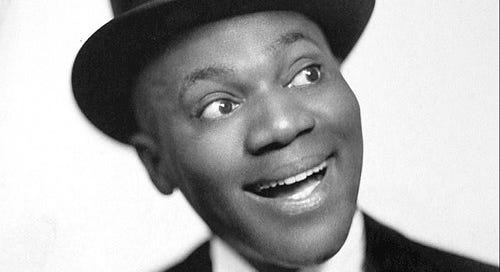The legend of Bill “Bojangles” Robinson begins with the crisp sound of tap shoes striking a wooden stage or wooden stairs. It was like listening to magic. And one could feel the warmth and joy in Bill's gleaming smile as he tap danced for the cameras in a film or an audience in a theater.
That legend changed an art form. There’s often a question about how art rises to prominence. How much is the timing? How much is the remarkable talent of an individual? For Bill, the timing was right. Slavery had ended. And black artistry in performance had begun attracting large crowds and national attention. But his exceptional talent also brought much interest to the craft. Some say he was the greatest tap dancer ever. He was certainly beloved by many, most of all the common people. Maybe they admired him because in a time when black dancers were expected to shuffle and stoop in minstrel fashion, Bill danced upright - light on his feet, head held high. Proud.
Yet, Bill's artwork and life came with contradictions and criticisms. He was charming and generous, an optimist. And at the same time, a gambler with a temper who got into fights. People criticized him for often playing a butler on a plantation in films. Then, came one of the most significant moments in his career. In 1935, Bill starred alongside child actor Shirley Temple in The Little Colonel. In one scene, the two tap danced together, marking the first interracial dance number in a mainstream American film. The joyful routine collided with a segregated nation. In parts of the South, theaters cut the scene entirely.
But throughout his controversies and challenges, Bill, born in the South just a decade after the Civil War and orphaned as an infant, rose to earn millions of dollars and open doors for many performers while helping society expand in appreciation and understanding. When he passed away in 1949 at the age of 71, about 3,000 were inside the Church for the funeral, with about 10,000 people outside. It was the largest in New York City history. Schoolchildren in Harlem, where he died, had part of the day off. And the Mayor of New York City delivered the eulogy. And as one person remarked in a speech that day,
“Here before us this afternoon, my beloved friends of Harlem and those of you from outside our community, there rests the remains of a legend, for Bill was a legend. Born within the shadow of slavery and dying at the middle of the twentieth century, the most glorious century of mankind, Bill Robinson was a legend. He was a legend because he was ageless and raceless. Long after his bones have disintegrated and gone back to the kindred elements from whence they came, little kids from uptown and downtown and all around the states will be dancing up and down the stairs that Bill Robinson first discovered. He was a legend because, though he was an artist, he never missed an opportunity, whether seeing a little boy on the corner, or Shirley Temple in Hollywood, of teaching part of his artistry to someone on the way up. And that’s greatness, too. Too often, people who are great like to keep what they have for themselves, but Bill was always ready to teach anyone, anywhere, how to dance. He was a legend because he was raceless. Bill wasn’t a credit to his race, meaning the Negro race, Bill was a credit to the human race. He was not a great Negro dancer, he was the world’s greatest dancer. Bill Robinson was Mr. Show Business himself.”
Sources:
Boskin, Joseph. The Journal of Southern History, vol. 56, no. 1, 1990, pp. 146–47. JSTOR, https://doi.org/10.2307/2210699. Accessed 23 May 2025.
DURKIN, HANNAH. “‘TAP DANCING ON THE RACIAL BOUNDARY’: RACIAL REPRESENTATION AND ARTISTIC EXPERIMENTATION IN BILL ‘BOJANGLES’ ROBINSON’S STORMY WEATHER PERFORMANCE.” IJAS Online, no. 2, 2010, pp. 98–106. JSTOR, http://www.jstor.org/stable/26234258. Accessed 25 May 2025.
Haskins, Jim. Mr. Bojangles: The Biography of Bill Robinson. William Morrow and Company, 1988. https://archive.org/details/mrbojanglesbiogr00hask
Markowitz, Judith A. The Power of Pride: Stylemakers and Rulebreakers of the Harlem Renaissance. Southern Illinois University Press, 2003. https://archive.org/details/powerofpridestyl0000mark/mode/2up
Wikimedia Commons, Wikimedia Foundation, https://commons.wikimedia.org/wiki/File:Bill_Bojangles_Robinson_1942.jpg





Fabulous dancer and performer! So glad we have him film.
Thank you for sharing the story and the hope that transcends race.
https://substack.com/@poetpastor/note/p-163242554?r=5gejob&utm_medium=ios&utm_source=notes-share-action